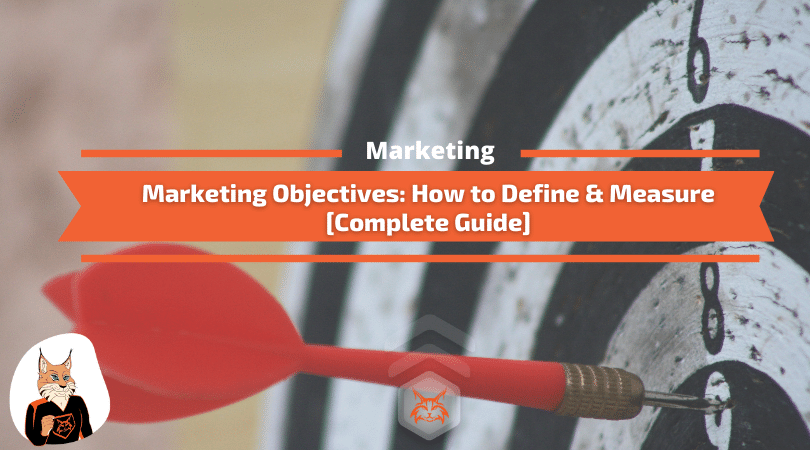A list of strategic and clear marketing objectives is at the core of any great marketing plan.
Marketing objectives are a brand’s defined goals. They outline the marketing team’s intentions, provide clear directions for team members, and offer information for executives to review and support.
Marketing objectives are a pivotal part of a marketing strategy. Without defined goals, a brand will struggle to achieve its plans because it won’t be clear on what it wants to do. A straightforward plan is required to know what you hope to do and how you plan to do it.
So, if you’re developing a marketing strategy with a vision but lack a concrete list of marketing objectives, use this guide to improve and upgrade your plans.
You will be far more likely to reach your goals when they are defined, outlined, and compiled into a clear list of measurable marketing objectives.
How to Choose Marketing Objectives
The first step in creating a helpful list of marketing objectives is reviewing the options you have for your strategy.
While there are many goals you can outline in your marketing plans, some of the most frequently used examples of marketing objectives include the following goals. Consider the stage and position of your brand, and select two or three marketing objectives to focus on.
Example of Marketing Objectives
Promote New Products or Services
If your upcoming plans include launching new offerings, your marketing objectives should consist of promoting those new products and services.
Grow Digital Presence
Suppose your brand doesn’t have a large footprint online. In that case, your marketing plans may be to start search engine optimization (SEO) and grow your visibility in search engine rankings and social media platforms.
Lead Generation
If your pipeline isn’t complete, you may want to focus on lead-generation tactics that grow your email list and fill your client relationship management (CRM) system with qualified prospects.
Target New Customers
You may choose this goal if you already have a loyal client base but want to expand and reach new audiences, customers, and clients.
Retain Existing Customers
Rather than focus on new customer acquisition, you may want to keep the existing customers you already have.
Build Brand Awareness
If your brand is new or only known to a small audience, one marketing objective you could focus on is expanding your reach and getting more people to learn about it.
Develop Brand Loyalty
If audiences already know your brand, you may want to focus on building awareness and a more profound brand affinity and loyalty.
Increase Sales and Revenue
If you sell products or services, you may want to focus on selling more. This marketing objective will increase revenue and the amount of money coming into your business.
Increase Profit
This marketing objective is different from increasing sales and revenue because you may increase your profit through means other than selling more. This objective may include cutting expenses and overhead, selling more items with higher margins, or making other changes that increase profit (which may not necessarily increase revenue).
Expand Into a New Market
If your brand is well-known or successful in a specific industry or geographic area, you may want to expand into a new target market, vertical, or location.
Grow Market Share
Instead of expanding into a new area, you may want to expand your footprint in your current market. This objective helps you attract more customers in your industry or geographic location.
Build Industry Authority
Becoming an expert is another way to grow your visibility in an industry. You can focus on establishing your brand as an authority in your vertical.
It may be tempting to look at this list and want to choose five, ten, or even all of the marketing strategies. However, it’s important to note that you should keep your marketing objectives relatively short. Focus on two to three objectives, then create plans to revisit and refocus on other goals later.
How to Define Clear Marketing Objectives
Once you know which marketing objectives to focus on, it’s time to examine their details.
Outlining the marketing goals you want to accomplish is not enough. You must also validate your plans and ensure they are practical, helpful, and reasonable. You must check to see if your objectives are SMART.
SMART marketing objectives are:
- Specific: The goals are clearly defined and outlined so the whole team understands the objective and why it’s essential.
- Measurable: The goals have key performance indicators (KPI) and benchmarks that allow you to measure success.
- Achievable: The goals are within your company and team’s ability. While you want to set a high bar, you must also remember to set goals within your means so you don’t set your team up for failure.
- Relevant: The goals are relevant to your brand mission and the direction of your business. It would be best if you had good reasons for your marketing objectives.
- Time-bound: The goals need a timeline that indicates when the objectives begin and end.
The type of marketing objective that works best is SMART. So, use this method to check your goals to ensure they are worth pursuing.
KPIs to Assign to Marketing Objectives
Once you know your marketing objectives and goals, it’s time to figure out how to measure them.
As mentioned above, successful goal setting requires setting KPIs and benchmarks for your plans. You must assign numbers, deadlines, and metrics to your marketing objectives.
KPIs and marketing metrics allow you to evaluate progress along the way and assess results at the end of your campaign. Without benchmarks for your goals, you will not know if your work was successful.
So, as you lay out your marketing plan, assign relevant KPIs to help you assess and measure your work output. The following metrics are examples of KPIs you could use.
Example KPIs for Marketing Objectives
Sales Growth
To improve your sales, monitor your revenue (income coming into your business) and the number of units sold. Both metrics will help you gain insight into whether your sales are growing. Monitor changes over specific time frames and during the duration of campaigns or marketing initiatives to see trends and fluctuations.
Changes in Profit
Changes in profit, or ROI, don’t necessarily mean increases in revenue or sales. It monitors your profit margins, which is how much you take in after your expenses and costs.
Market Share
Your market share is the market portion that your brand or product controls. This metric helps you compare your company to others in your industry and identify ways to reach your growth potential. You need to know your current market share to measure changes in your market share.
To find your market share, consider your industry’s total revenue and market size or geographic location. Then, divide your company’s revenue by the market’s income. This calculation will give you an estimate of the percentage of the market your brand controls.
Lead Generation
There are many ways to measure lead generation metrics. Depending on your marketing objectives, you should determine which metrics best measure your success.
- Number of leads: total number of new leads brought in
- Increase in leads: percentage change in lead generation compared to other time frames
- Cost per lead: the amount of money spent to acquire one new lead
- Conversion rate: the percentage of your traffic that becomes a lead after visiting your website
You can also break down these metrics into SQLs (sales-qualified leads) and MQLs (marketing-qualified leads) to get a more detailed look at your data.
New Customer Acquisition
When in a growth phase, you should monitor new customer acquisition and the metrics that help you monitor growth. The following are KPIs that measure customer acquisition.
- Number of new customers: the number of new customers acquired over a certain period
- Increase in new customers: percentage change of new customers compared to other time frames
- Cost per new customer: the amount of money spent to acquire a new customer
- Lead-to-customer ratio: Percentage of leads that become paying customers
Lifetime Value of a Customer
Consider these metrics if you’re focused on marketing objectives that relate to your current customer base and keeping those shoppers and clients happy.
- Number of repeat customers: number of customers who return
- Customer retention rate: percentage of customers who return
- Lifetime spend: average amount customers spend with a company over their lifetime
Learn how to calculate customer lifetime value (CLV)
Customer Spend
You may also want to examine metrics related to individual, one-time purchases. Monitor the average spend per customer to determine the most common ticket sizes for each shopper or client.
Conversion Rates
You should constantly monitor conversion rates when running campaigns with intended results (e.g., a customer making a purchase, a website visitor signing up for a free trial, an audience clicking on a link in an email, etc.).
Conversion rates are the percentage of people who perform the desired action when presented with an option to do so. Track conversion rates for all your landing pages, website opt-ins, email links, free trial sign-ups, or other calls to action in your marketing campaigns.
Website Metrics
When your marketing objectives include digital plans, it’s essential to monitor web analytics and online KPIs that tell you how well your site performs.
- Sessions: number of visits to a website
- Unique visitors: the number of amazing people who visit a website
- Page views per visit: average number of pages a website visitor views on a website
- Bounce rate: the percentage of website visitors who leave a site after viewing only one page
- Time on site: the average amount of time that website visitors stay on a site
Social Media Engagement
When engaging in digital strategies related to social media, you may also want to utilize KPIs related to social performance.
- Increase in fans/followers: the number of new followers/fans acquired over a certain period.
- Number of comments: number of comments left on your posts or updates
- Number of shares: number of times your content was shared
- Number of opt-ins: number of leads generated through your social campaigns and posts
- Traffic to the website from social media sources: the percentage of your website traffic that is referred by social media sites
SEO Performance
If your marketing plans include improving your visibility in search, monitor KPIs that will enhance your SEO status. To get an accurate look at these metrics, use Alexa tools to track (and improve) your numbers.
- Alexa Rank: a measure of how popular a website is compared to other websites (the lower a website’s number, the more popular it is)
- Number of sites linking in the number of websites that have published a link to a website
- Keyword share of voice: the percentage of searches for a target keyword that lead back to a website
After reviewing this list of KPIs, consider which metrics will offer the best insights into your goals and objectives. Assign numbers and use benchmarking to monitor your progress toward accomplishing your goals.
Assigning metrics and reviewing your results will help you gain insights into which strategies worked and are worth additional time and resources. It will also help you improve your processes and find more success in the future.
Conclusion
Even the most ambitious and inspired marketing strategy can’t succeed without an essential element – clearly outlined and measurable marketing objectives. So, as you create upcoming marketing strategies, use this list of objectives, guidelines for SMART goals, and KPIs to develop plans that are defined, outlined, measurable, and far more likely to succeed.
Source: blog.alexa.com






